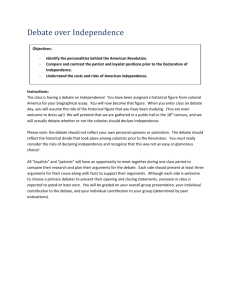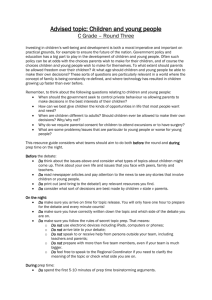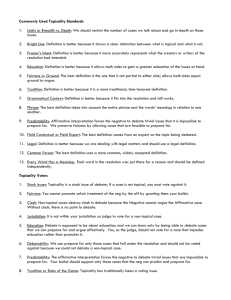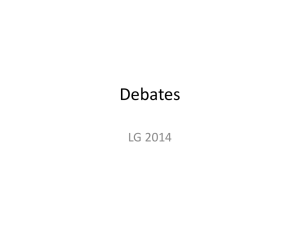An Introduction to Your Ballot – Example
advertisement
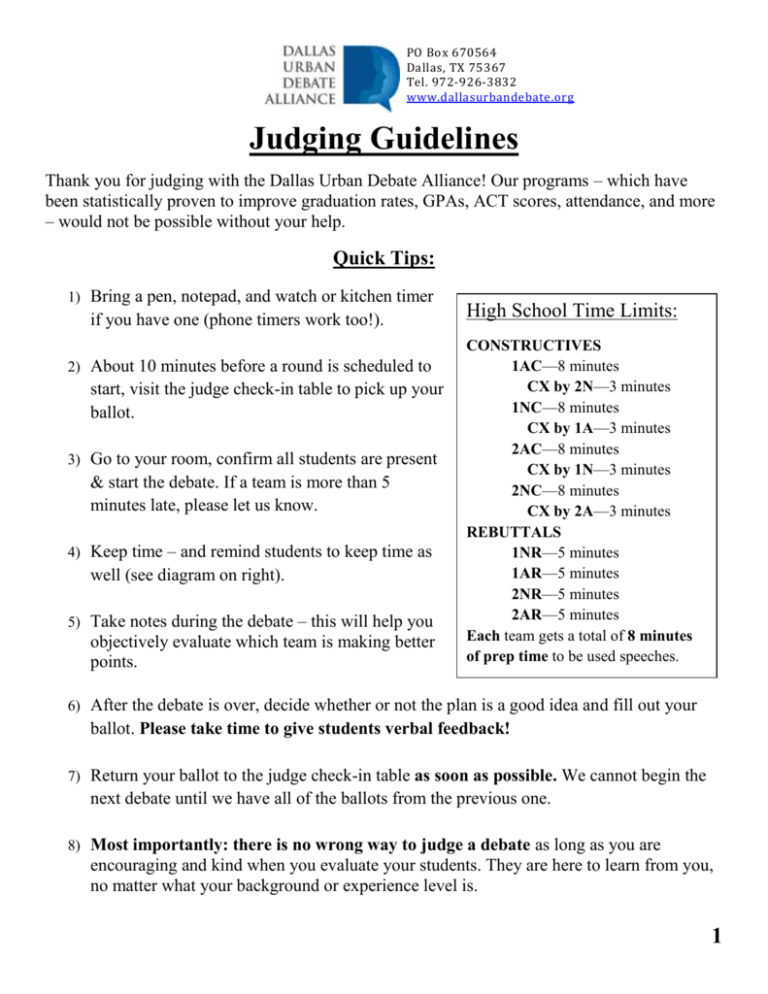
PO Box 670564 Dallas, TX 75367 Tel. 972-926-3832 www.dallasurbandebate.org Judging Guidelines Thank you for judging with the Dallas Urban Debate Alliance! Our programs – which have been statistically proven to improve graduation rates, GPAs, ACT scores, attendance, and more – would not be possible without your help. Quick Tips: 1) Bring a pen, notepad, and watch or kitchen timer if you have one (phone timers work too!). 2) About 10 minutes before a round is scheduled to start, visit the judge check-in table to pick up your ballot. 3) Go to your room, confirm all students are present & start the debate. If a team is more than 5 minutes late, please let us know. 4) Keep time – and remind students to keep time as well (see diagram on right). 5) Take notes during the debate – this will help you objectively evaluate which team is making better points. High School Time Limits: CONSTRUCTIVES 1AC—8 minutes CX by 2N—3 minutes 1NC—8 minutes CX by 1A—3 minutes 2AC—8 minutes CX by 1N—3 minutes 2NC—8 minutes CX by 2A—3 minutes REBUTTALS 1NR—5 minutes 1AR—5 minutes 2NR—5 minutes 2AR—5 minutes Each team gets a total of 8 minutes of prep time to be used speeches. 6) After the debate is over, decide whether or not the plan is a good idea and fill out your ballot. Please take time to give students verbal feedback! 7) Return your ballot to the judge check-in table as soon as possible. We cannot begin the next debate until we have all of the ballots from the previous one. 8) Most importantly: there is no wrong way to judge a debate as long as you are encouraging and kind when you evaluate your students. They are here to learn from you, no matter what your background or experience level is. 1 PO Box 670564 Dallas, TX 75367 Tel. 972-926-3832 www.dallasurbandebate.org 2 PO Box 670564 Dallas, TX 75367 Tel. 972-926-3832 www.dallasurbandebate.org Introduction to Debate Policy debate is an intellectual competition between two sides – the Affirmative and the Negative. Each side is represented by a 2 person team from a Dallas ISD school. Each debate is supervised by a judge (you). During the debate, the Affirmative team advocates a policy. The Negative team will argue that policy is a bad idea. Your job, as the judge, is to decide if the plan is a good idea – as well as to evaluate the quality of each student’s presentation. The affirmative team will present a policy in their first speech that reflects the year’s topic (a.k.a. resolution). This year, the topic is about the United States and our economic relationship to Latin American countries: Resolved: The United States federal government should substantially increase its economic engagement toward Cuba, Mexico or Venezuela. Thus, an example of a policy that is relevant to the topic (what we call “topical”) would be a piece of legislation that lifts the embargo on Cuba, allowing for more trade. 3 PO Box 670564 Dallas, TX 75367 Tel. 972-926-3832 www.dallasurbandebate.org Introduction to this Year’s Arguments In line with our mission of making debate more accessible, we restrict all non-Varsity debaters to sets of pre-produced research packets called “Core Files.” This helps us ensure that students have a controlled introduction to advanced debate topics and concepts. It is important that students do not deviate from their Core Files, which can skew the fairness of a debate – if someone in Novice or JV reads non-DUDA evidence, simply don’t use it to make your decision. Please note: If you are new to judging debate rounds, you will be assigned judge in the Novice Division. If you have judged before, you may be assigned to Junior Varsity or Varsity debates as well. Novice Division Files Novice debates in the Fall of 2013 will focus exclusively on the Cuban Embargo. Affirmative teams will argue that we should lift the 50+ year old embargo on Cuba, claiming it: hurts Cuban public health, strengthens the Cuban governments’ repressive policies, and undermines US/Latin American cooperation. Negative teams may contest the points brought up by the affirmative or argue that lifting the embargo would lead to dangerous oil drilling operations and create a surge in tourism that could be harmful for Cuba. JV Division Files - JV debaters receive the Cuba File described above, and a few more arguments: A Venezuelan Oil affirmative, which argues that the United States should invest in improvements to Venezuela’s oil production facilities. This would arguably maintain stable oil supplies, guard against political instability in Venezuela, and improve the US’ image in Latin America. Negative teams may argue that a surge in Venezuelan oil production (and US oil consumption) would undermine the economies of other countries that produce and consume oil, causing instability. A Development Bad Kritik, which allows them to argue that US-led development in Latin America is based on a bad economic model that sacrifices Latin Americans’ best interests for the sake of making a profit. A Topicality File, which allows them to argue that various affirmatives aren’t “topical” (relevant to the topic), and thus undermine the educational potential of debate. Please note: you may want to take topicality debates in JV with a grain of salt, since we produced the files for the students. 4 PO Box 670564 Dallas, TX 75367 Tel. 972-926-3832 www.dallasurbandebate.org An Introduction to Speech Orders & Times Like any sport, we have rules that set how long students can speak and what order they speak in. Every debater will give two speeches (an 8 minute constructive and a 5 minute rebuttal), will be cross-examined once, and will cross-examine another student once. Here are the speeches in order: 1st Affirmative Constructive (1AC) – the speaker introduces the affirmative’s case. 1st Negative Constructive (1NC) – this speech will introduce the arguments that the negative team will use during the debate. 2nd Affirmative Constructive (2AC) – this speaker refutes all of the arguments made by the negative by reading new evidence & referencing evidence from the first affirmative speech. “The Negative Block:” 2nd Negative Constructive (2NC) 1st Negative Rebuttal (1NR) – the negative debaters split up the arguments from the first negative speech and flesh them out while answering affirmative arguments. 1st Affirmative Rebuttal (1AR) – this speaker has a limited amount of time to answer the arguments made in the block and to re-assert the affirmative case. 2nd Negative Rebuttal (2NR) – this is the last negative speech – this speaker’s job is to provide a clear set of reasons why the negative team should win the debate. Think of this speech like a conclusion to a paper – it’s about quickly summarizing why the negative should win. 2nd Affirmative Rebuttal (2AR) – this is the last speech in the debate – this speaker should quickly refute the negative’s best arguments and then refocus the debate on why the affirmative plan is best. Cross-Examination (CX) and Prep Time: Cross-examination – is a 3-minute question and answer session after each constructive, when the opposing team asks the person who just spoke questions in order to clarify or point out the flaws of an argument. Preparation time – each team is given 8 minutes of “prep-time” that they can take at any point before or after a speech to write notes, find evidence, organize their thoughts, etc. To use it, students simply need to announce that they want to take some prep time. They only get 8 minutes of prep time for the whole debate, so they need to use it wisely! 5 PO Box 670564 Dallas, TX 75367 Tel. 972-926-3832 www.dallasurbandebate.org An Introduction to Rendering Your Decision There can only be one winner, and it’s your job to choose who it is. The official record of who wins and loses is noted on the ballot you pick up before each debate – but we really hope you’ll take time to offer verbal feedback to students as well! Giving a decision at the end of the debate: Your decision should center on whether the plan is a good idea or not – this is policy debate, after all. Restrict your decision to arguments that were presented in the debate – refrain from interjecting your own beliefs/opinions about the subject. Make an independent decision without consulting other judges. It is generally considered inappropriate to discuss the arguments being made with other judges before you have given your decision/written your ballot. Most importantly, don’t tell teams to do more research or find new evidence – this would interfere with the argument restrictions we have in place and our students may not have access to research facilities. Filling out your ballot to reflect your decision (see next page for example): Win/Loss – this is the easiest to enter. Simply write which team won the debate. Speaker Points – reflect the quality of individual speakers, and can be used to reward good persuasive techniques, humor, knowledge of the topic, etc. Speaker points range from 0 to 30 – but we ask that you restrict your points to a range of 25-29.5. Here is a rough idea of the scale: 29.5 Points: Virtually Perfect. You can’t think of anything they could do to improve. 29 Points: Well above average. An extremely good speaker. Unusually effective; highly persuasive. 28 Points: A good speaker. Slightly above average. Clear room for improvement. 27 Points: Average. With strengths, but also with unmistakable flaws. 26 Points: Below average. An ineffective speaker. Please list 1-2 specific ways this speaker could improve in addition to leaving positive comment. 25 Points: Something particularly offensive or egregious occurred. Ranks – the best student receives a rank of 1, second best a 2, onward to 4. These are used as tiebreakers by tournament staff if speaker points are equal. Low Point Wins – because the decision reflects the best policy and not the best debating, it is possible for the better debaters to lose. If the losing team receives more points or ranks than the winning team, Please check the box on the ballot marked as “low point win.” 6 PO Box 670564 Dallas, TX 75367 Tel. 972-926-3832 www.dallasurbandebate.org An Introduction to Your Ballot – Example 7


